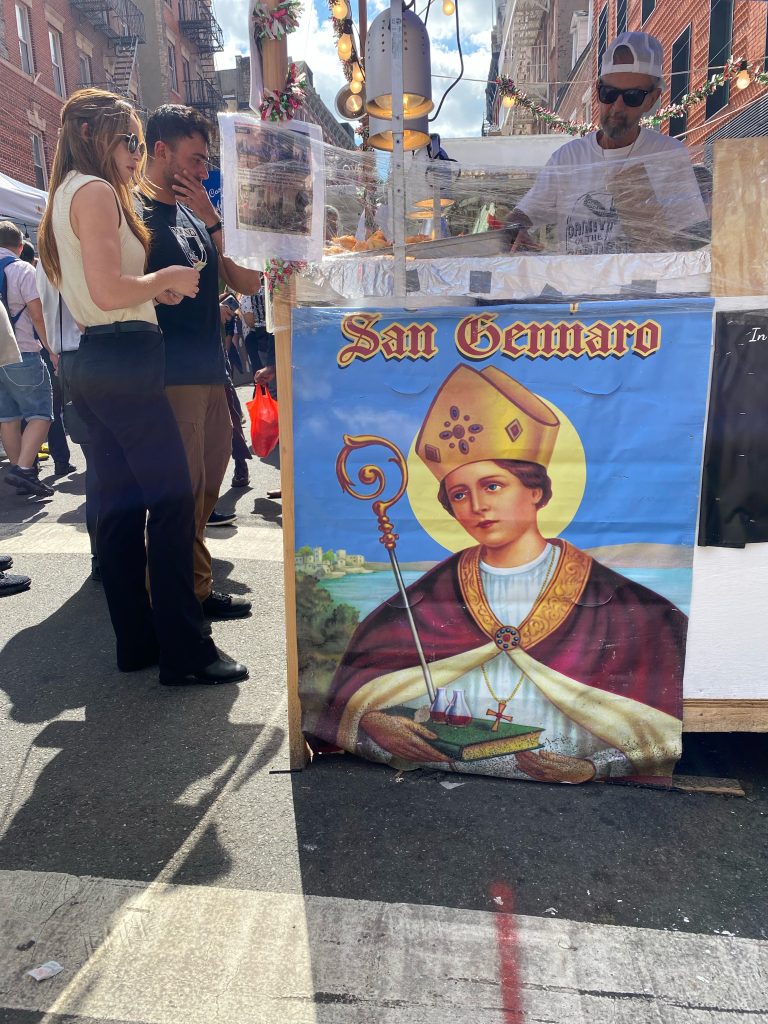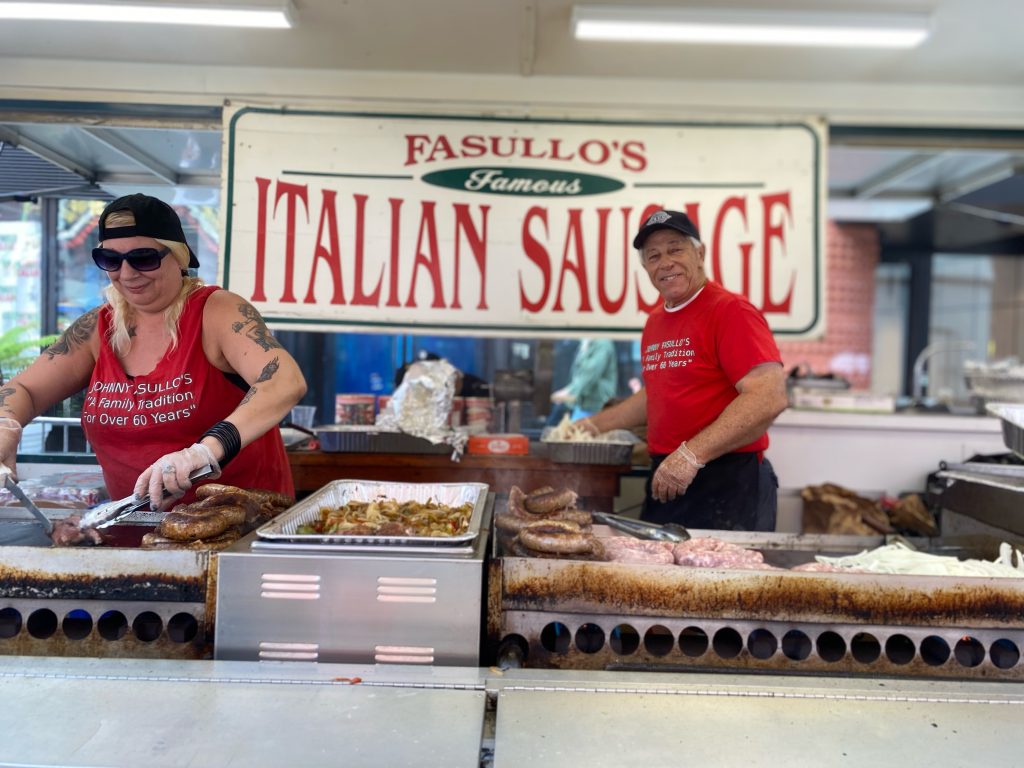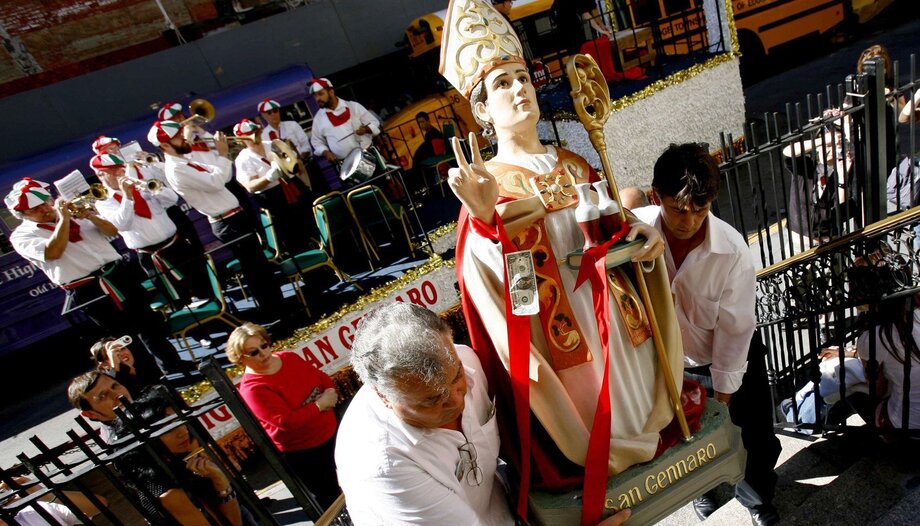









Autumn is in the air, and cannoli, zeppole, and sausage, and pepper sandwiches abound on Mulberry Steet- and every other square in New York's Little Italy neighborhood. This must mean that La Festa di San Gennaro has begun.
The San Gennaro Feast, as we call it in English, runs from September 14 to September 24. It is New York City longest-running festival and, undoubtedly, the most famous. Nothing says September in New York like La Festa di San Gennaro. Most people who grew up in the Tri-State area, and even outside of it, remember going to the Feast. But who was Saint Gennaro, and how did he become Little Italy's patron saint?


Italy was 'unified' in 1861, but political disunity remained in the mentality and sub-conscious minds of many of the Italians who immigrated to America. And they brought similar suspicions of the Italians who weren't their paisano-fellow townsmen. The large influx of Italians who came during the late 1800s were from the south. And southern Italian villages were insular and isolated, and Italians wanted to preserve that in their new country. "In Italy, this spirit of village cohesion was known as campanilismo—loyalty to those who live within the sound of the village church bells," notes the Library of Congress (LOC).
The apparent differences among the regions, such as dialects, food, and patron saints, would explain why the Italians from the same or nearby towns in Italy chose to live close together. Like all new immigrants, the Italians wanted to preserve their language, local traditions, and customs. This helped maintain the unity of the village. The festa was one tradition that piqued the interest of outsiders. It is a day celebrating a particular village's saint, and the residents follow an image or statue of their beloved saint. Italians cherished their dear saints as much as their food, so it is no surprise the Neapolitans would bring San Gennaro to L'America.
By the early 1920s, more than 4 million Italians had immigrated to the United States of America, and the Library of Congress reports that they "represented more than 10 percent of the nation's foreign-born population." An estimated 391,000 Italians had settled in the New York Region, in Brooklyn, the Bronx, and right across the river, in New Jersey. However, the highest concentration resided in Lower Manhattan, where many would live under some of the most horrific living conditions.
Little Italy had become a southern Italian enclave. Mulberry Street, where La Festa Di San Gennaro would eventually take place, was like a snapshot of a Neapolitan village.
The first Feast occurred in 1926 and has been going on for over 97 years. To the locals, it is known as the "Feast of all Feasts." It celebrates faith and culture, and there is always enough food. It all started when the Italian residents wanted to pay San Gennaro (San Januarius) homage.
Saint Gennaro, Italian martyr
San Gennaro was born in Benevento, Campania, around 272 AD. He is the patron saint of Naples, Italy. His feast day is celebrated every year on September 19, the anniversary of his martyrdom. When he was the bishop of Benevento, it was a time of rampant Christian persecutions, and it was at that time he would seal his fate: when he demonstrated his faith in Christ and showed how he was unafraid of the Roman Empire. Like many of our martyred Catholic saints, he was bold and undeterred of the powers of this world; he kept his gaze and focus upon God, not those who thought themselves to be Gods.
Emperor Diocletian spearheaded the genocide of Christians during this period, and many were imprisoned and killed. Bishop Gennaro would "sign his death warrant" when he visited two deacons and one layman in jail. He went to pray for them despite the inevitable consequences.
He was arrested and tortured and would eventually be beheaded. However, it is believed that decapitation was ordered only after San Gennaro was able to "calm the beasts who were initially supposed to kill him." Samples of his blood were collected by a faithful person and stored in a special place. Three times a year at the Duomo di Napoli, vials of San Gennaro's dried blood are displayed, and the faithful wait for its liquefaction, known as the "Miracle of San Gennaro."
The Neapolitans in Italy and the many who left their small southern towns over a century ago with little money or education prayed to San Gennaro for protection from fires, earthquakes, plagues, and anything they needed. Their descendants still pray to him and celebrate him every year.
Omnes strolled through the San Gennaro Feast on September 19 and spoke to some of the long-time residents and business owners.
Nicky Criscitelli was born and raised on Mulberry Street and owns Da Nico. His great-grandmother and grandfather were involved in the Feast since the 1940s. He shared: "My grandfather was the first one to make mini pizzas, and my great-grandmother sold peanuts, Torrone, and cookies, [and] she had a store. She was from Naples." I asked him whether or not San Gennaro is still thought of today and whether it's less about him and more about the food and festivities. He answered, "It's all about Saint Gennaro… it's all about Saint Gennaro, that's what the whole Feast is about!"














